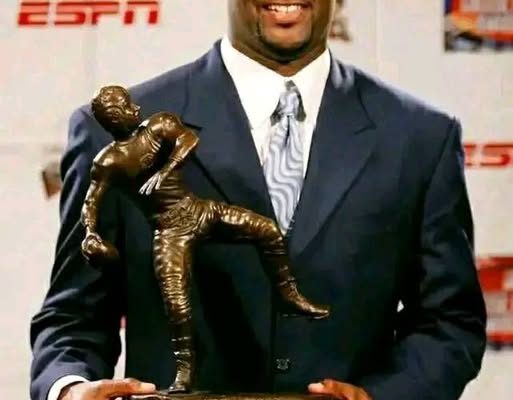AUSTIN, TX — In a recognition befitting his place in college football lore and beyond, Vince Young, the legendary former Texas Longhorns quarterback and cultural icon, has been named to TIME Magazine’s annual list of the 100 Most Influential People in the world. For many Texans, sports fans, and those who followed his remarkable journey, this honor feels less like a surprise and more like the culmination of a legacy that has been years in the making. Young’s impact has always gone far beyond what he accomplished on the football field, but this latest accolade serves as yet another reminder that his story is one of both athletic brilliance and cultural resonance. TIME Magazine’s list is not about who can run the fastest or throw the farthest; it’s about who changes conversations, inspires others, and leaves a permanent mark on society. Vince Young fits that definition in a way few athletes ever have. For many, his name will always be linked to the 2006 Rose Bowl, arguably the greatest performance in college football history, when he led Texas to a thrilling 41-38 victory over USC, sealing the national championship with a now-iconic 8-yard touchdown run on fourth down with just seconds remaining. That moment didn’t just give Texas fans a lifetime memory—it instantly elevated Young to legendary status in the sport. It was the type of performance that gets replayed endlessly, discussed in documentaries, and etched into the minds of everyone who saw it live. But what TIME is honoring goes deeper than game-winning touchdowns. Young’s career, both during and after football, has been defined by the way he carried himself as a symbol of hope, perseverance, and connection. Raised in Houston’s tough South Side, Young overcame adversity from an early age, turning personal challenges into fuel for greatness. His journey from a high school phenom at Madison High to a Heisman Trophy runner-up and ultimately a first-round NFL draft pick was not just about athletic skill; it was about inspiring young people who saw in him the possibility of rising above difficult circumstances. The truth is, Young’s influence began long before this recognition. In Texas, he became a cultural figure whose jersey was worn not only by college football fans but by kids in neighborhoods who might never have stepped foot inside Darrell K Royal–Texas Memorial Stadium. He embodied confidence without arrogance, leadership without pretense, and his style of play brought an electricity to the field that went beyond X’s and O’s. Coaches called him a once-in-a-generation talent, but his charisma made him even more compelling. After his NFL career—which began with a promising Rookie of the Year season in 2006 and included two Pro Bowl appearances—Young’s life took turns both challenging and rewarding. Injuries, team changes, and personal struggles made his path less linear than some might have predicted during his Texas glory days. But through it all, he maintained a connection to his community, giving back through charitable foundations, mentoring young athletes, and using his platform to speak about resilience, financial literacy, and life after sports. This authenticity is part of why his inclusion in TIME’s 100 resonates so strongly. He is not simply being recognized for peak athletic moments, but for the full arc of his story—success, setbacks, and the ability to rise again. In recent years, Young has dedicated himself to uplifting the next generation. He has been a special assistant in the Texas Longhorns athletic department, helping guide student-athletes both on and off the field. He’s also been involved in programs aimed at underserved youth, emphasizing education, personal responsibility, and the importance of self-belief. His voice carries weight not only because of what he achieved, but because he speaks from experience. Many young athletes listen to him not as a distant legend but as someone who understands the highs and lows of chasing a dream. TIME Magazine’s acknowledgment of Young’s influence also highlights the way sports figures have evolved in public life. In today’s world, the line between athlete, activist, and public figure is increasingly blurred. Young’s career and post-career contributions fit into this modern mold, where the value of an athlete’s legacy is measured as much by the change they inspire as the trophies they win. For Young, that means being a role model in ways that transcend statistics. His journey speaks to themes of redemption, perseverance, and community, which are as relevant to corporate boardrooms and classrooms as they are to football stadiums. When Young accepted the honor, his reaction reflected that humility and gratitude. He has long credited his family, coaches, and teammates for shaping his life and career, and his words to TIME centered on the idea of using influence responsibly. That mindset reinforces why this award is more than just a symbolic nod—it’s an acknowledgment that Young has leveraged his platform to positively affect lives far beyond Austin or Houston. The timing of this recognition is also meaningful. Texas Longhorns football is in the midst of a resurgence, with renewed energy and aspirations of returning to national prominence. Having one of their greatest icons celebrated on a global stage not only excites the fan base but also serves as a reminder to current players of the standard set by those who came before them. Young’s image, already immortalized in statues and highlight reels, is now further validated by his place among leaders, innovators, and changemakers from all walks of life. What makes Young’s story especially compelling is the duality of his influence. On one hand, he is the athlete who delivered perhaps the most memorable performance in college football history. On the other, he is a man who has navigated the challenges of life after sports with openness and determination. That combination makes him relatable to a wide spectrum of people, from aspiring athletes to business professionals to anyone striving to overcome personal hurdles. In honoring Young, TIME Magazine is also acknowledging the broader cultural significance of Texas football itself. The Longhorns have always been more than just a team—they are a symbol of pride for the state and a touchstone for generations of fans. Vince Young’s role in that tradition is unmatched; he didn’t just win games, he elevated the program’s stature in a way that still resonates nearly two decades later. His name remains synonymous with victory, leadership, and big-game poise. For Young, this recognition is a testament to staying true to oneself through the inevitable changes that come after athletic fame. While his professional career had its ups and downs, his unwavering commitment to helping others, especially young people from similar backgrounds, has defined his second act. In a sports culture that often forgets its heroes once they retire, Young has managed to remain relevant by continually finding ways to give back and remain connected. In Austin, where his legend was forged, the news of his inclusion on the TIME list has been met with universal celebration. Fans recall the moments he gave them—the elation of a championship, the pride of watching one of their own achieve greatness—and they see this honor as both deserved and overdue. For those who grew up watching him, it reaffirms that heroes can age into mentors, and legends can evolve into leaders. The beauty of Young’s journey lies in its imperfections. His influence is not built solely on uninterrupted success but on the lessons learned from challenges. It’s the kind of influence that lasts, because it’s rooted in authenticity. In recognizing him, TIME is telling the world that Vince Young is not just a sports icon; he is a cultural figure whose story continues to inspire. That influence will endure as long as young athletes dream of playing under the bright lights, as long as people seek examples of resilience, and as long as the University of Texas keeps the memory of that magical January night in 2006 alive. In many ways, the man who once scrambled past defenders to the end zone is still moving forward, still finding ways to win, and still carrying with him the hopes of those who see in his story a reflection of their own possibilities. And now, the world has officially taken notice.
AUSTIN, TX — In a recognition befitting his place in college football lore and beyond, Vince Young, the legendary former Texas Longhorns quarterback and cultural icon, has been named to TIME Magazine’s annual list of the 100 Most Influential People in the world.



